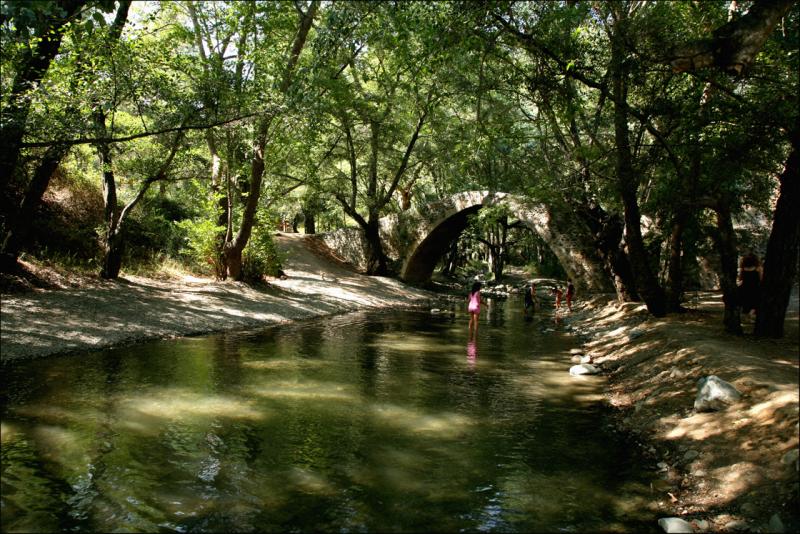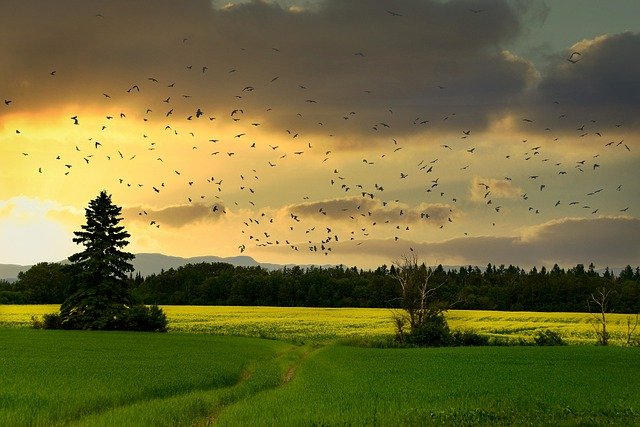Author: 1st Grade Lower Secondary, Olympion High School, CY
Partners: 1st Grade Lower Secondary, Volissos High School, GR; 1st Grade Upper Secondary, SS Vela Luka, HR
Introduction

Phil-AEK's - Επί φόρτωση στη Βικιπαίδεια από τον Tony Esopi, CC BY-SA 3.0 GR
The children explored a very interesting topic, which is already included in the Biology course of the 1st grade of Gymnasium, in Cyprus. The ultimate goal was to become familiar with this topic through the process of conducting research and finding information. They explored the biodiversity of Cyprus and the influence of climatic and human factors. To complete this activity, the children were divided into groups. Each group addressed different issues such as:
- The creation of a climatic profile of Cyprus and what are the expected vegetation zones based on their knowledge in the Geography course.
- Bibliographic research on the plant species that exist in Cyprus. Study of the species of Flora in the mountains and comparison with areas where the human factor is large.
- Bibliographic research on the animal species of Cyprus. Study of fauna species in the mountains and comparison with areas where the human factor is significant.
- Identification of human actions that affect the biodiversity of Cyprus in a negative way.
- What actions can we take to reverse the reduction of biodiversity.
Cyprus is the third largest island in the Mediterranean. Despite its small size, Cyprus is rich in biodiversity. This is a result of the different geomorphological sites that we find on the island, the intense changes in temperature and rainfall from region to region as well as the location of Cyprus at the crossroads of three continents. The island is characterized by a unique flora as more than 1900 plant species have been identified, of which 140 are endemic and are not found anywhere else in the world. There are also 52 different habitat types in Cyprus, of which 5 occur exclusively on the island. Regarding the fauna, 36 species of mammals have been recorded on the island so far, of which 19 are bats, 13 species are land mammals, 3 dolphins and 1 species of seal. The largest of these is the endemic wild (Ovis gmelini ophion). Cyprus is located on one of the eight main routes of birds from Europe to Africa and vice versa. The birds that have been recorded so far in Cyprus amount to 380 species. Of these, 53 reside in Cyprus and the others stay temporarily. Six of those that reside in Cyprus are considered endemic. Also in Cyprus live 22 species of reptiles of which 8 are snakes, 11 are lizards and 3 turtles, 2 marines. There are also 3 species of amphibians (frogs). The variety of insects found in Cyprus is also rich, of which 52 species are butterflies with 9 endemic species. As in the rest of our planet, the phenomenon of poaching is intense. The removal of species from food chains results in an immediate disruption of the number of other species coexisting in a habitat.
Learning Objectives
- To use modern technology productively in the environmental study of an area.
- To be able to correlate the factors that affect an ecosystem with the biodiversity of the area.
- To link the content of the Biology course with internet information, journalistic articles and videos of Cypriot scientists.
- To create their own material regarding the biodiversity of Cyprus as well as the human factor.
Task

https://pixabay.com/photos/countryside-birds-sunset-landscape-6633849/
In this particular SeedQuest, the students:
- will explore the biodiversity of Cyprus and the influence of climatic and human factors;
- will discover the importance of peaceful human coexistence with all creatures as a means to thrive and survive.
At the end of the SeedQuests, the students:
- will be more aware of the unique flora and fauna of Cyprus.
Process
After the topic was announced to the students, they were divided into groups of 3-4. They were assigned the activities, which they had to accomplish and present to the class in the form of a presentation. The resources at their disposal were various links from the internet.
Group 1
Activity 1: Information search
This Group of students had to create a climatic profile of Cyprus and what are the expected vegetation zones based on their knowledge in the Geography course.
The Group had to cooperate online because of the Covid-19 emergency. The students used cloud storage systems like Google Drive and Dropbox and scheduled online meetings to discuss their progress. They used a Google shared ppt template where each student contributed to the PowerPoint content creation.
Activity 2: Green invasion
The Group is asked to think of ways to transform common public spaces into green areas. The students have to select a well-known area in their city/neighbourhood that lacks green. How would they improve it and make it more friendly for the people and the environment?
Group 2
Activity 1: Information search
The first activity for this Group was to do bibliographic research on the plant species that exist in Cyprus. Study of the species of Flora in the mountains and comparison with areas where the human factor is large. Once they had all the information collected, they created a PowerPoint presentation.
The Group had to cooperate online because of the Covid-19 emergency. The students used cloud storage systems like Google Drive and Dropbox and scheduled online meetings to discuss their progress. They used a Google shared ppt template where each student contributed to the PowerPoint content creation.
Activity 2: Let's do the planet hunt.
Students are asked to download the Pl@ntNet mobile application https://plantnet.org/comment-pourquoi/
The teacher gives them the description of some plants and they will have to find the correct name using the App.
Group 3
Activity 1: Information search
The first activity for this Group was to do Bibliographic research on the animal species of Cyprus. Study of fauna species in the mountains and comparison with areas where the human factor is significant. Once they had all the information collected, they created a PowerPoint presentation. The Group had to cooperate online because of the Covid-19 emergency. The students used cloud storage systems like Google Drive and Dropbox and scheduled online meetings to discuss their progress. They used a Google shared ppt template where each student contributed to the PowerPoint content creation.
Activity 2: Let me take you far away
In the Covid times, when travelling is risky, this App could take you on a knowledge trip to the Natural History Museum (https://play.google.com/store/apps/details?id=air.com.nhm.london.vusiem&hl=en_US&gl=US) How these species got extinct?
Group 4
Activity 1: Information search
The first activity for this Group was to identify human actions that affect the biodiversity of Cyprus in a negative way. Once they had all the information collected, they created a PowerPoint presentation. The Group had to cooperate online because of the Covid-19 emergency. The students used cloud storage systems like Google Drive and Dropbox and scheduled online meetings to discuss their progress. They used a Google shared ppt template where each student contributed to the PowerPoint content creation.
Activity 2: Name me
Students are asked to use the Pl@ntNet App to find the names of plants while they walk in the city. Using chalk they could write the name of the plant they found next to it.
Group 5
Activity 1: Information search
The first activity for this Group was to think of what actions can we take to reverse the reduction of biodiversity. Once they had all the information collected, they created a PowerPoint presentation. The Group had to cooperate online because of the Covid-19 emergency. The students used cloud storage systems like Google Drive and Dropbox and scheduled online meetings to discuss their progress. They used a Google shared ppt template where each student contributed to the PowerPoint content creation.
Activity 2: Become a hero
Students are asked to download the Earth Hero: Climate Change App from Google Play (https://play.google.com/store/apps/details?id=com.earthheroorg.earthhero&hl=en_US&gl=US) Using the App they have to calculate their carbon footprint and search for ideas to improve their lifestyle.
Evaluation
- Understand the great impact that biodiversity has on climate change and the reckless action of humans.
- Understand the importance of environmental awareness and how it can affect an ecosystem in the long run.
- Understand how daily habits affect their environment.
- Familiarization with the process of online research.
- Develop critical analysis skills.
- Develop communication and collaboration skills in the context of teamwork.
- Methodological skills in research.
- Personal development and satisfaction.
- Study organization.
- Internet navigation competencies.
- Use and processing of data from the internet.
Conclusion
Students through this work gained many skills both cognitive and emotional. They learned how to conduct research and critically process all the information they gather from the internet, as well as prepare it in presentations. They have also realized that with the right communication and collaboration techniques, teamwork bears fruit.
Links
BIODIVERSITY OF THE FORESTS OF CYPRUS
http://www.moa.gov.cy/moa/fd/fd.nsf/fd95_gr/fd95_gr?OpenDocument
BIODIVERSITY OF COASTAL ECOSYSTEMS
http://www.moa.gov.cy/moa/dfmr/dfmr.nsf/page13_gr/page13_gr?OpenDocument
Teachers Section
Unfortunately, our work was limited to literature research due to the pandemic conditions we face. The students rarely went out into the mountains and this was done on an individual level. It is very important for students to get out of the classroom and for knowledge to take shape in front of their eyes.










